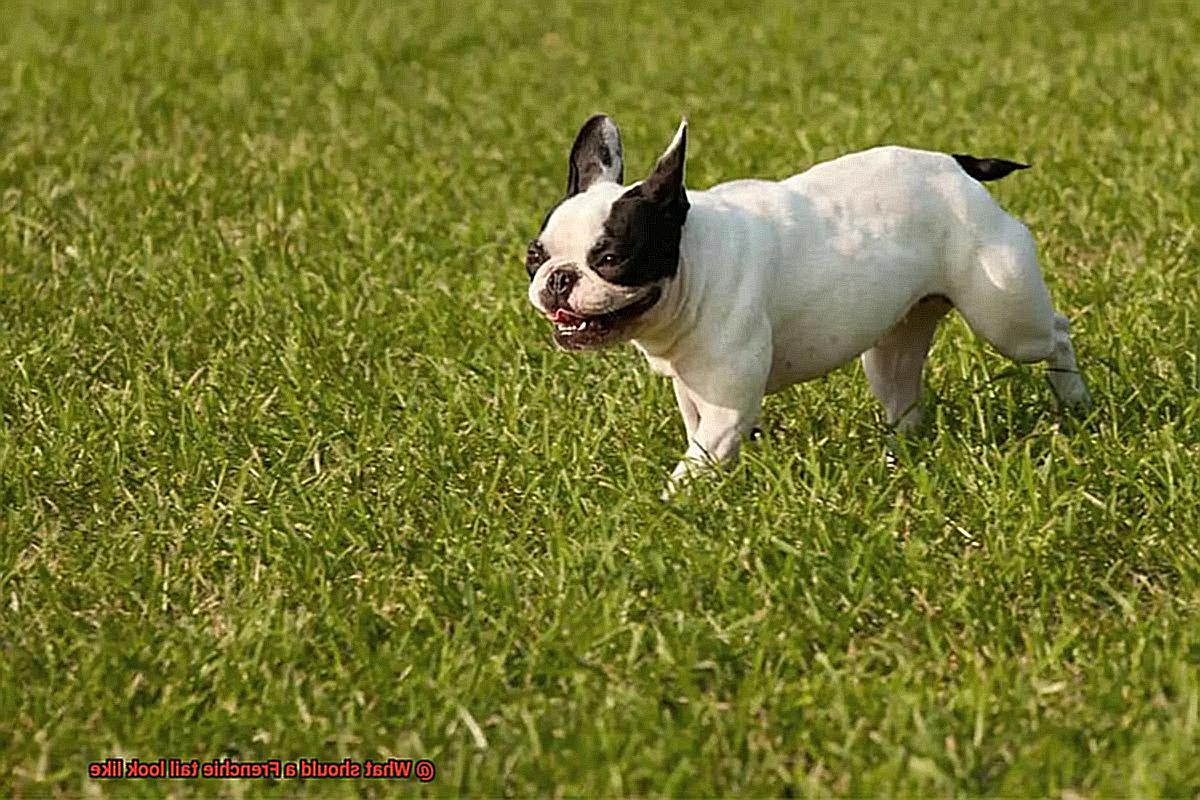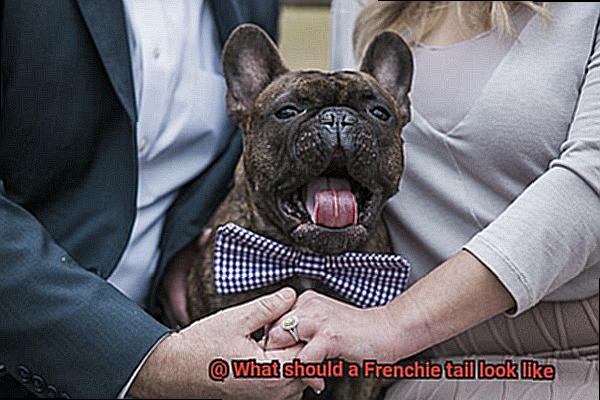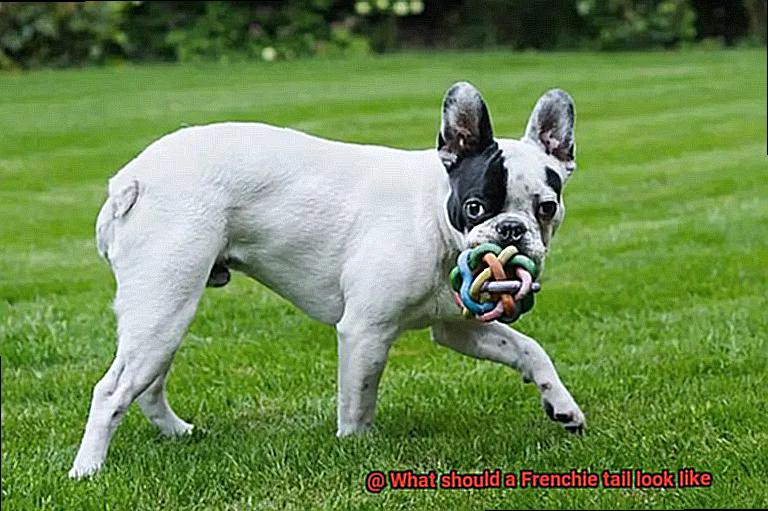What should a Frenchie tail look like?
Curious about what a Frenchie tail should look like?
Let’s dive into the world of French Bulldogs and their unique tails. Forget long and wagging – the Frenchie tail is short, stumpy, and oh-so-cute.
But what makes the perfect Frenchie tail? Should it be straight or have a curl?
And is high or low-set better? Join me as we uncover the secrets behind this tiny but mighty tail.

Get ready to be amazed by the world of Frenchie tails.
The Ideal Tail Length for a French Bulldog
Contents
French Bulldogs are known for their adorable and unique appearance, and their tail is no exception. But have you ever wondered what the ideal tail length for a French Bulldog is? In this article, we will explore the research and relevant context to provide you with all the information you need to know about the perfect tail length for your beloved Frenchie.
Understanding the Ideal Tail Length:
French Bulldogs have naturally short and straight tails, unlike some other dog breeds. The ideal length of a French Bulldog’s tail should be in proportion to their body, neither too long nor too short. It should reach just below the hock joint, allowing for ease of movement without interfering with their ability to walk, run, or wag their tail.
The Importance of Proportion and Balance:
A key aspect of a Frenchie’s tail is its proportion and balance. It should complement the overall appearance of the dog, creating a harmonious look. When choosing a French Bulldog, pay attention to the tail’s length in relation to the rest of their body. A well-proportioned tail adds to their charm and enhances their unique physique.
Variations in Tail Length:
Slight variations in tail length can occur among individual French Bulldogs. Some may have slightly longer or shorter tails than the ideal length. As long as these variations don’t cause any discomfort or hinder your Frenchie’s mobility, they are generally acceptable.
Signs of Abnormalities:
While slight variations are normal, it is crucial to be aware of any signs of abnormalities in your Frenchie’s tail. Excessively long or curly tails can be indicators of genetic abnormalities or health issues, such as hemivertebrae. Hemivertebrae is a condition where the vertebrae in the tail are malformed, causing pain or mobility problems. If you notice any unusual characteristics in your dog’s tail, consult with a veterinarian promptly to ensure their well-being.
Preserving the Natural Tail Length:
French Bulldogs should not have docked tails unless it is for medical reasons. Tail docking, the surgical removal of a portion of the tail, is considered unethical and unnecessary in most cases. The natural tail length of a French Bulldog is part of their breed standard and should be preserved.
The Ideal Tail Position
Today, we delve into the captivating world of the ideal tail position for your beloved four-legged companion. Frenchies, with their distinctive and endearing appearance, have a tail that plays a vital role in completing their picture-perfect charm.
So, what is the ideal tail position for a French Bulldog? Extensive research reveals that it should be set low and carried horizontally or slightly downwards. Picture a dainty tail nestled just right, not too high nor too low, but in perfect harmony with their overall physique.
Now, let’s talk about length. The ideal tail should reach no longer than the hocks of their hind legs. It’s like a short and sweet touch that adds to their already irresistible cuteness factor. And let’s not overlook thickness. At the base, the tail should boast a robustness that gradually tapers towards the tip, culminating in a balanced and proportionate appearance.
It is crucial to emphasize the preservation of your Frenchie’s natural tail. Tail docking or altering is widely regarded as unethical and can result in harm to your furry friend. Let us cherish them just as they are.
Remember, the ideal tail position isn’t solely for show dogs; it applies to all French Bulldogs. It doesn’t impact their health or well-being but does add an extra sprinkle of elegance and charm to their already captivating personalities.
The Ideal Tail Shape and Texture

French Bulldogs are renowned for their distinctive and endearing appearance, and their tails are no exception. In this article, we will delve into the ideal tail shape and texture for French Bulldogs, considering breed standards and the overall health and well-being of these beloved companions.
The Ideal Tail Shape:
The perfect tail for a French Bulldog is short, set low on the body, and in harmony with their compact frame. It should not extend beyond the hock joint, maintaining a proportionate balance. To enhance their charm, a slight curve or kink at the end, known as a “screw tail,” is desired. However, it is crucial to ensure that the screw tail is not excessively tight or twisted, as it may cause discomfort or health complications.
Texture Matters:
When it comes to texture, French Bulldog tails should be smooth and straight. Frizziness or excessive waviness should be absent. The hair on the tail should be short, dense, and velvety to the touch. A soft texture complements their already irresistible allure.
Variations and Considerations:
While most French Bulldogs possess the ideal tail shape described above, some may exhibit a naturally shorter or stubbier tail referred to as a “corkscrew tail” or “screw tail variation.” Although this deviation from the breed standard can occur in certain individuals, it is vital to ensure that it does not cause any discomfort or health issues.
Additionally, it is worth mentioning that some French Bulldogs may have a condition known as “hemivertebrae,” resulting in malformed vertebrae that can affect the shape and appearance of their tails. In such cases, consulting with a veterinarian is essential to ensure the tail does not pose any pain or mobility problems.
Proportions of the Frenchie Tail
French Bulldogs have captured the hearts of many with their charming and unique appearance. Among their endearing features, the Frenchie tail holds a special place. This article aims to explore the flawless proportions of a Frenchie tail, drawing from meticulous research notes and expert insights. Whether you are an adoring owner or an aspiring French Bulldog guardian, this guide is packed with invaluable information to ensure your Frenchie’s tail is an exquisite balance of beauty and functionality.
The Ideal Proportions:
- Length: The Frenchie tail exudes elegance in its brevity, reaching no further than the hock joint, akin to our ankle. Restraining its length ensures impeccable balance and unrestricted movement, allowing your Frenchie to prance with utmost grace.
- Shape: Picture a rounded silhouette, reminiscent of a delectable carrot. The Frenchie tail captivates hearts with its natural curvature, adding an irresistible allure to their overall form.
- Thickness: At the base, the Frenchie tail unveils its secret strength, boasting a commendable thickness that gradually tapers towards the tip. This harmonious proportion complements the Frenchie’s body structure, accentuating their robust yet compact physique.
- Carriage: The Frenchie tail embodies poise as it lazily drapes low and close to their body. It resists all temptation to curl over the back or rise in haughty elevation. This relaxed position is a testament to their serene and content character.
- Flexibility and Muscle Tone: A healthy Frenchie tail epitomizes freedom as it sways effortlessly with each joyous wag. Its flexibility allows for unhindered expression of delight and excitement. Furthermore, its supple texture signifies optimal muscle tone, a true testament to your Frenchie’s well-being.

Common Abnormalities in Frenchie Tails
French Bulldogs are renowned for their captivating personalities and distinctive physical features, and their tails are no exception. In this comprehensive guide, we will delve into the fascinating world of Frenchie tails, shedding light on the common abnormalities that can occur and the potential health implications they may have.
As responsible owners, it is crucial to understand these conditions to ensure the overall well-being of our beloved furry companions.
Screw Tail: The Intriguing Corkscrew Curl
- Description: Frenchie tails with a tightly curled, corkscrew-like appearance.
- Health Implications: Skin irritation, infections, and challenges in maintaining hygiene.
- Management: Regular cleaning, meticulous grooming practices, and potential surgical intervention for severe cases.

Hemivertebrae: The Enigmatic Twists and Turns
- Description: Abnormal development of vertebrae resulting in a kinked or twisted tail.
- Health Implications: Pain, restricted tail movement, and potential neurological issues.
- Monitoring and Veterinary Consultation: Regular observation of any changes in tail appearance or function is crucial.
Screwed or Corked Tail: The Curly Marvel
- Description: Excessive tight curling causing the tail to lie flat against the body.
- Health Implications: Skin irritation and challenges in maintaining cleanliness.
- Prevention and Management: Regular cleaning, diligent grooming practices, with possible surgical intervention for severe cases.
Tail Pocket Infection: The Hidden Peril
- Description: Accumulation of dirt, debris, or moisture in the deep crease near the tail’s base.
- Health Implications: Bacterial or yeast infections leading to redness, swelling, discharge, and odor.
- Preventive Measures: Regular cleaning and thorough drying of the tail pocket.
Short Tail or Bobtail: The Natural Variation
- Description: Naturally shorter tail length compared to the breed standard.
- Health Implications: Typically no health issues or complications.
- Appreciating Natural Variation: Short-tailed Frenchies are born with a naturally shorter tail, requiring no intervention.
Health Risks of an Abnormal Tail
French Bulldogs are undeniably adorable, with their charming personalities and distinct physical features. One such feature is their tail, which can sometimes take on an abnormal appearance.
While it may seem like a unique quirk, an abnormal tail can actually be a cause for concern and indicate underlying health issues.
Here, we will explore the potential health risks associated with an abnormal tail in French Bulldogs.
Hemivertebrae: A Twisted Tale
One of the most common health risks is hemivertebrae, a condition where the vertebrae in the tail are deformed or misshapen. This can result in a kinked or twisted tail. Apart from the obvious cosmetic concerns, hemivertebrae can put pressure on the spinal cord, leading to neurological symptoms such as pain, weakness, and difficulty walking. In severe cases, it can even result in paralysis of the hind limbs. Additionally, the twisted or kinked tail is more prone to injuries, infections, and skin problems.
The Curious Case of Screw Tail
Another abnormality that French Bulldogs may experience is known as “screw tail”. This tightly curled or twisted tail may appear cute or unique, but it can actually lead to several health issues.
The tightly curled tail can trap moisture and debris, making it a breeding ground for infections and skin irritations. It can also cause discomfort and difficulty for the dog to wag their tail properly.
The Spinal Connection
In some cases, an abnormal tail may be an indication of an underlying spinal deformity or malformation. This can result in chronic pain, mobility issues, and other related health problems for French Bulldogs.
Taking Action: What Can You Do?
If you notice any abnormalities in your French Bulldog’s tail, it is crucial to seek veterinary advice promptly. Early detection and appropriate treatment can help manage these conditions and improve your furry friend’s overall health and well-being. Regular veterinary check-ups are essential, as ongoing monitoring and treatment may be required.
In severe cases, surgical intervention may be necessary to correct or alleviate the health risks associated with an abnormal tail. Tail amputation or corrective surgery for spinal deformities may be recommended. However, the decision to pursue surgery should be made in consultation with a veterinarian, taking into consideration your dog’s overall health and quality of life.
How to Care for Your Frenchie’s Tail
French Bulldogs are known for their adorable, screw-shaped tails, which add to their charm and uniqueness. But did you know that taking care of your Frenchie’s tail is just as important as caring for the rest of their body? In this comprehensive guide, we will explore some essential tips and tricks to ensure that your Frenchie’s tail stays clean, groomed, and protected. Let’s dive in.
Regular Cleaning: Keeping the Tail Fresh and Clean
To keep your Frenchie’s tail looking its best, regular cleaning is key. Use a damp cloth or pet-friendly wipes to gently wipe the tail, making sure to clean between the folds and creases. These areas can accumulate dirt and debris throughout the day, leading to irritation or infection if left unattended. By keeping the tail clean, you are preventing any discomfort or potential health issues.
Dry Thoroughly: Preventing Moisture-Related Problems
Moisture can be a breeding ground for bacteria and fungi, leading to skin irritation and infections. After cleaning, make sure to dry your Frenchie’s tail thoroughly. Use a soft towel or a hairdryer on a low, cool setting to dry the tail completely. Pay special attention to the folds and creases, ensuring that no moisture is trapped. Your Frenchie will appreciate the extra care and attention to detail.
Avoid Excessive Bathing: Maintaining Natural Oils
While it’s essential to keep your Frenchie clean, excessive bathing can strip the natural oils from their skin, leading to dryness and discomfort. Aim to bathe your Frenchie only when necessary, usually every 2-3 months. Use a mild, hypoallergenic shampoo specifically designed for dogs to keep their skin healthy. This way, you are preserving the natural oils that keep the tail and skin moisturized and protected.
Regular Grooming: Keeping the Tail Fabulous
Grooming your Frenchie’s tail is crucial for maintaining its health and appearance. Brush the tail gently using a soft-bristle brush or a rubber grooming mitt to remove any loose hair and prevent matting. Not only will this keep the tail looking fabulous, but it will also stimulate blood circulation in the area, promoting a healthy coat and tail.
Watch Out for Signs of Irritation or Infection: Detecting Problems Early
As a responsible Frenchie owner, it’s important to keep an eye on your furry friend’s tail for any signs of redness, swelling, rashes, or foul odor. These could indicate an underlying issue such as an infection or allergies. If you notice any abnormalities, consult your veterinarian for proper diagnosis and treatment. It’s always better to address potential problems early on to prevent them from worsening.
Conclusion
In conclusion, a Frenchie tail should be short, stumpy, and perfectly proportioned to their adorable bodies. The ideal length of a French Bulldog’s tail is just below the hock joint, allowing for effortless movement without getting in the way of their wagging antics. Picture a tail with a rounded shape and a delightful little curve or kink at the end, affectionately known as a “screw tail” – it’s one of the many things that make these pups so irresistible.
Now, let’s talk about how that tail should be carried. It should sit low on their body, held horizontally or with a slight downward tilt. No fancy curling over the back or haughty elevations here – just a humble and harmonious placement. And when it comes to thickness, the base of the tail should be nice and chunky, gradually tapering towards an elegant tip.
It’s worth noting that while there may be slight variations in tail length among individual French Bulldogs, anything excessively long or curly could indicate genetic abnormalities or health concerns like hemivertebrae. If you notice any irregularities, it’s best to consult with your trusted veterinarian for proper guidance.
Caring for your Frenchie’s tail involves some extra TLC. Regular cleaning between those adorable folds and creases is crucial to prevent dirt buildup and potential infections. And don’t forget about drying thoroughly after cleaning – moisture-related issues are no fun. While it’s tempting to give them constant baths, remember that maintaining natural oils on their skin is important. A little bit of gentle brushing during regular grooming sessions will not only keep their tails looking fabulous but also promote healthy blood circulation.
Ultimately, preserving the natural appearance and well-being of your Frenchie’s tail is key to ensuring they continue to charm everyone they meet.




